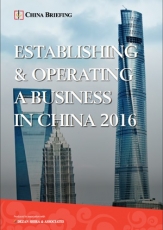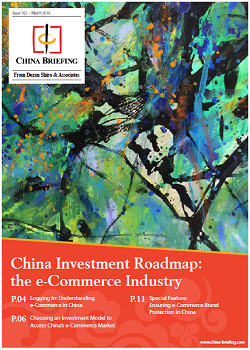China Market Watch: New Cross Border e-Commerce Policies Suspended
Confirmation of One Year Suspension of New Policies for Cross Border e-Commerce
On May 25, the Ministry of Finance (MOF) confirmed that the proposed regulatory requirements for cross border e-commerce will be granted a one year transition period. This means that before May 11, 2017, customs clearance forms will not be examined for online purchased bonded goods entering the country’s 10 pilot cities of Tianjin, Shanghai, Hangzhou, Ningbo, Zhengzhou, Guangzhou, Shenzhen, Chongqing, Fuzhou, and Pingtan. In addition, initial import licensing approval, registration, and filing requirements for cosmetics, infant formula milk powder, medical devices, special food (including healthcare food, formula food for special medical purpose), and other such products will be suspended. Furthermore, goods imported under the direct sale model to all regions of China will be temporarily exempt from the initial import licensing approval, registration, and filing requirements.
![]() RELATED: Business Advisory Services from Dezan Shira & Associates
RELATED: Business Advisory Services from Dezan Shira & Associates
China’s Third-Party Payment Sector and New Regulations
China’s third-party mobile payment market exceeded RMB nine trillion in 2015, an increase of over 50 percent on the previous year. This number is forecasted to reach RMB 12.2 trillion by the end of this year and RMB 18.3 trillion by 2018. Alibaba Group’s Alipay comprised the largest market share of 72.9 percent in 2015, while Tenpay took 17.4 percent. However, new restrictions will come into force on July 1, 2016, requiring third-party online payment services to ensure that user accounts bear the real name of the account holder. In addition, accounts will be sorted into three types based on security requirements. Maximum annual payments will be imposed on these account types, with a limit of RMB 1,000 daily spending on the least secure type to RMB 200,000 for the most secure. With Apple Pay entering China, the world’s largest smartphone market, third party mobile payment is becoming increasingly competitive.
China’s ATM Industry Growth
China’s total ATM installations have experienced double digit growth every year since their introduction to the country in 1985. As of the end of 2015, China had nearly 850,000 network connected ATM units, up nearly 45 percent year on year, with a CAGR of 27.2 percent during the period of 2007–2015. This figure is expected to reach 1.5 million units by 2020. Despite the rapid growth rate of ATMs in China over the years, there is still a huge gap between units per million people. As of the end of 2015, there were only 626 units per million, compared to 1,409 per million in the US in 2014. However, the number of bank cards accepted by each ATMs was 6,246, above the international provisional standard of 4,000. Therefore, China’s ATM industry presents a large market potential, especially in rural areas.
China’s April Trade Figures Signal Further Economic Decline
China’s exports in April were down two percent compared to the same month last year, while imports also fell by nearly two percent. The export sector has shown the same slowdown trend over the last 10 months, and China’s economic growth has dropped to its slowest rate in nearly 25 years. As for imports, April was the 18th consecutive month of decline, highlighting further weakening in domestic consumer demand. Despite a 3.2 percent growth of exports to the European Union, exports to China’s largest market, the U.S., have fallen by 9.3 percent. The Chinese government has expressed aims to boost exports by encouraging bank lending and increasing tax rebates for some companies. A slight increase in March’s figures have been identified as a potential anomaly.
|
Asia Briefing Ltd. is a subsidiary of Dezan Shira & Associates. Dezan Shira is a specialist foreign direct investment practice, providing corporate establishment, business advisory, tax advisory and compliance, accounting, payroll, due diligence and financial review services to multinationals investing in China, Hong Kong, India, Vietnam, Singapore and the rest of ASEAN. For further information, please email china@dezshira.com or visit www.dezshira.com. Stay up to date with the latest business and investment trends in Asia by subscribing to our complimentary update service featuring news, commentary and regulatory insight. |

 Establishing & Operating a Business in China 2016
Establishing & Operating a Business in China 2016
Establishing & Operating a Business in China 2016, produced in collaboration with the experts at Dezan Shira & Associates, explores the establishment procedures and related considerations of the Representative Office (RO), and two types of Limited Liability Companies: the Wholly Foreign-owned Enterprise (WFOE) and the Sino-foreign Joint Venture (JV). The guide also includes issues specific to Hong Kong and Singapore holding companies, and details how foreign investors can close a foreign-invested enterprise smoothly in China.
China Investment Roadmap: the e-Commerce Industry
In this edition of China Briefing magazine, we present a roadmap for investing in China’s e-commerce industry. We provide a consumer analysis of the Chinese market, take a look at the main industry players, and examine the various investment models that are available to foreign companies. Finally, we discuss one of the most crucial due diligence issues that underpins e-commerce in China: ensuring brand protection.
 Selling, Sourcing and E-Commerce in China 2016 (First Edition)
Selling, Sourcing and E-Commerce in China 2016 (First Edition)
This guide, produced in collaboration with the experts at Dezan Shira & Associates, provides a comprehensive analysis of all these aspects of commerce in China. It discusses how foreign companies can best go about sourcing products from China; how foreign retailers can set up operations on the ground to sell directly to the country’s massive consumer class; and finally details how foreign enterprises can access China’s lucrative yet ostensibly complex e-commerce market.
- Previous Article INFORME ESPECIAL Asegurando la protección de marca en el e-Commerce en China
- Next Article Auflösung einer Repräsentanz in China – Teil 2











